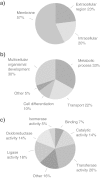The ovarian transcriptome of the cattle tick, Rhipicephalus (Boophilus) microplus, feeding upon a bovine host infected with Babesia bovis
- PMID: 24330595
- PMCID: PMC4028808
- DOI: 10.1186/1756-3305-6-276
The ovarian transcriptome of the cattle tick, Rhipicephalus (Boophilus) microplus, feeding upon a bovine host infected with Babesia bovis
Abstract
Background: Cattle babesiosis is a tick-borne disease of cattle with the most severe form of the disease caused by the apicomplexan, Babesia bovis. Babesiosis is transmitted to cattle through the bite of infected cattle ticks of the genus Rhipicephalus. The most prevalent species is Rhipicephalus (Boophilus) microplus, which is distributed throughout the tropical and subtropical countries of the world. The transmission of B. bovis is transovarian and a previous study of the R. microplus ovarian proteome identified several R. microplus proteins that were differentially expressed in response to infection. Through various approaches, we studied the reaction of the R. microplus ovarian transcriptome in response to infection by B. bovis.
Methods: A group of ticks were allowed to feed on a B. bovis-infected splenectomized calf while a second group fed on an uninfected splenectomized control calf. RNA was purified from dissected adult female ovaries of both infected and uninfected ticks and a subtracted B. bovis-infected cDNA library was synthesized, subtracting with the uninfected ovarian RNA. Four thousand ESTs were sequenced from the ovary subtracted library and annotated.
Results: The subtracted library dataset assembled into 727 unique contigs and 2,161 singletons for a total of 2,888 unigenes, Microarray experiments designed to detect B. bovis-induced gene expression changes indicated at least 15 transcripts were expressed at a higher level in ovaries from ticks feeding upon the B. bovis-infected calf as compared with ovaries from ticks feeding on an uninfected calf. We did not detect any transcripts from these microarray experiments that were expressed at a lower level in the infected ovaries compared with the uninfected ovaries. Using the technique called serial analysis of gene expression, 41 ovarian transcripts from infected ticks were differentially expressed when compared with transcripts of controls.
Conclusion: Collectively, our experimental approaches provide the first comprehensive profile of the R. microplus ovarian transcriptome responding to infection by B. bovis. This dataset should prove useful in molecular studies of host-pathogen interactions between this tick and its apicomplexan parasite.
Figures


Similar articles
-
Analysis of Babesia bovis infection-induced gene expression changes in larvae from the cattle tick, Rhipicephalus (Boophilus) microplus.Parasit Vectors. 2012 Aug 7;5:162. doi: 10.1186/1756-3305-5-162. Parasit Vectors. 2012. PMID: 22871314 Free PMC article.
-
Gut transcriptome of replete adult female cattle ticks, Rhipicephalus (Boophilus) microplus, feeding upon a Babesia bovis-infected bovine host.Parasitol Res. 2013 Sep;112(9):3075-90. doi: 10.1007/s00436-013-3482-4. Epub 2013 Jun 10. Parasitol Res. 2013. PMID: 23749091
-
Functional genomics studies of Rhipicephalus (Boophilus) annulatus ticks in response to infection with the cattle protozoan parasite, Babesia bigemina.Int J Parasitol. 2012 Feb;42(2):187-95. doi: 10.1016/j.ijpara.2011.12.003. Epub 2012 Jan 8. Int J Parasitol. 2012. PMID: 22265898
-
Unravelling the cellular and molecular pathogenesis of bovine babesiosis: is the sky the limit?Int J Parasitol. 2019 Feb;49(2):183-197. doi: 10.1016/j.ijpara.2018.11.002. Epub 2019 Jan 26. Int J Parasitol. 2019. PMID: 30690089 Free PMC article. Review.
-
Productivity and health effects of anaplasmosis and babesiosis on Bos indicus cattle and their crosses, and the effects of differing intensity of tick control in Australia.Vet Parasitol. 2008 Aug 1;155(1-2):1-9. doi: 10.1016/j.vetpar.2008.03.022. Epub 2008 Apr 7. Vet Parasitol. 2008. PMID: 18472219 Review.
Cited by
-
The multiple roles of peroxiredoxins in tick blood feeding.Exp Appl Acarol. 2018 Jul;75(3):269-280. doi: 10.1007/s10493-018-0273-8. Epub 2018 Jul 20. Exp Appl Acarol. 2018. PMID: 30030662 Review.
-
Deep Sequencing Analysis of the Ixodes ricinus Haemocytome.PLoS Negl Trop Dis. 2015 May 13;9(5):e0003754. doi: 10.1371/journal.pntd.0003754. eCollection 2015 May. PLoS Negl Trop Dis. 2015. PMID: 25970599 Free PMC article.
-
Saliva from nymph and adult females of Haemaphysalis longicornis: a proteomic study.Parasit Vectors. 2015 Jun 24;8:338. doi: 10.1186/s13071-015-0918-y. Parasit Vectors. 2015. PMID: 26104117 Free PMC article.
-
A multi-omics approach for understanding blood digestion dynamics in Ixodes scapularis and identification of anti-tick vaccine targets.Ticks Tick Borne Dis. 2024 Nov;15(6):102379. doi: 10.1016/j.ttbdis.2024.102379. Epub 2024 Jul 20. Ticks Tick Borne Dis. 2024. PMID: 39033644 Free PMC article.
-
More than Three Decades of Bm86: What We Know and Where to Go.Pathogens. 2023 Aug 22;12(9):1071. doi: 10.3390/pathogens12091071. Pathogens. 2023. PMID: 37764879 Free PMC article. Review.
References
-
- Grisi L, Massard CL, Moya Borja GE, Pereira JB. Impacto economico das principais ectoparasitoses em bovinos no Brasil. Hora Vet. 2002;6:8–10.
-
- Bock R, Jackson L, de Vos A, Jorgensen W. Babesiosis of cattle. Parasitology. 2004;6(Suppl):247–269. - PubMed
-
- Riek RF. The life cycle of Babesia argentina (Lignieres, 1903) (Sporozoa: Piroplasmidae) in the tick vector Boophilus microplus (Canestrini) Aust J Agric Res. 1966;6:247–254. doi: 10.1071/AR9660247. - DOI
-
- Sambrook J, Fritsch EF, Maniatis T. Molecular cloning a laboratory manual. New York: Cold Spring Harbor Laboratory Press; 1989.
Publication types
MeSH terms
Substances
LinkOut - more resources
Full Text Sources
Other Literature Sources
Molecular Biology Databases

